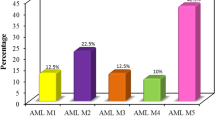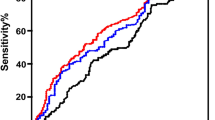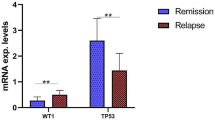Abstract
Chronic myeloid leukemia (CML) is a clonal hematopoietic stem cell disorder characterized by the presence of Philadelphia (Ph) chromosome. Wilms’ tumor gene 1 (WT1) plays an important role in leukemogenesis and can be useful as a molecular marker to detect minimal residual disease (MRD). The goal of this study was to evaluate WT1 expression and compare it with BCR-ABL1 expression in peripheral blood (PB) of CML patients, in order to explore the utility of WT1 as an alternative marker for MRD detection. Eighteen newly diagnosed CML patients (BCR-ABL1-p210-positive), 16 chronic CML patients with a history of imatinib therapy, and 18 normal individuals (BCR-ABL1-p210-negative) as controls were enrolled in this study. WT1 and BCR-ABL1 expression was evaluated by quantitative real-time polymerase chain reaction (Q-RT-PCR). Analysis of RT-PCR data was performed using REST Software (2009, QIAGEN, Valencia, USA). Data were analyzed by SPSS software (v.16.0) using Spearman’s rho and Kruskal-Wallis methods. WT1 expression in all PB samples of newly diagnosed CML patients was significantly higher than that of the normal individuals (P = 0.003). WT1 expression was not different in patients on imatinib therapy compared to normal individuals (P = 0.6), but it was significantly lower than that of the newly diagnosed CML patients (P = 0.001). There was no significant correlation between expression of WT1 and BCR-ABL1 and hematological findings in newly diagnosed CML patients. We confirm the oncogenic role of WT1 by WT1 upregulation in CML. Due to lack of significant correlation between BCR-ABL1 and WT1 expression, using WT1 as an additional marker for CML monitoring could not be applicable.



Similar content being viewed by others
References
Asgarian Omran H, Shabani M, Vossough P, Sharifian R, Tabrizi M, Khoshnoodi J et al (2008) Cross-sectional monitoring of Wilms’ tumor gene 1 (WT1) expression in Iranian patients with acute lymphoblastic leukemia at diagnosis, relapse and remission. Leuk Lymphoma 49(2):281–290
Asgarian H, Shabani M, Vosoogh P, Ali R, Sharifian SG, Khoshnoodi J et al (2005) Over-expression of Wilm’s Tumor Gene 1 (WT1) in Iranian patients with acute myeloblastic leukemia. Iran J Immunol 2(4):182
Babashah S, Rezaei-Tavirani M, Zamanian-Azodi M, Saki N (2012) Chronic myeloid leukemia as a stem cell-derived malignancy. J Paramedical Sci. 3(2)
Burchert A, Cai D, Hofbauer LC, Samuelsson MK, Slater EP, Duyster J et al (2004) Interferon consensus sequence binding protein (ICSBP; IRF-8) antagonizes BCR/ABL and down-regulates bcl-2. Blood 103(9):3480–3489
Bustin SA, Benes V, Garson JA, Hellemans J, Huggett J, Kubista M et al (2009) The MIQE guidelines: minimum information for publication of quantitative real-time PCR experiments. Clin Chem 55(4):611–622
Calabretta B, Perrotti D (2004) The biology of CML blast crisis. Blood 103(11):4010–4022
Call KM, Glaser T, Ito CY, Buckler AJ, Pelletier J, Haber DA et al (1990) Isolation and characterization of a zinc finger polypeptide gene at the human chromosome 11 Wilms’ tumor locus. Cell 60(3):509–520
Cao XS, Gu WY, Chen ZX, Hu SY, He J, Cen JN (2007) Bone marrow WT1 gene expression and clinical significance in chronic myelogenous leukemia. Zhonghua Nei Ke Za Zhi 46(4):277–279
Cilloni D, Saglio G, editors (2003) Usefulness of quantitative assessment of Wilms tumor suppressor gene expression in chronic myeloid leukemia patients undergoing imatinib therapy. Seminars in Hematology: Elsevier
Cilloni D, Messa F, Gottardi E, Fava M, Arruga F, Defilippi I et al (2004) Sensitivity to imatinib therapy may be predicted by testing Wilms tumor gene expression and colony growth after a short in vitro incubation. Cancer 101(5):979–988
Cilloni D, Renneville A, Hermitte F, Hills RK, Daly S, Jovanovic JV et al (2009) Real-time quantitative polymerase chain reaction detection of minimal residual disease by standardized WT1 assay to enhance risk stratification in acute myeloid leukemia: a European LeukemiaNet study. J Clin Oncol 27(31):5195–5201
Corrêa S, Binato R, Du Rocher B, Castelo-Branco MT, Pizzatti L, Abdelhay E (2012) Wnt/β-catenin pathway regulates ABCB1 transcription in chronic myeloid leukemia. BMC Cancer 12(1):303
Dong W, Zhang J, Shao N, Tian T, Li L, Jian J et al (2014) Development and immunological evaluation of HLA-specific chronic myeloid leukemia polyepitope vaccine in Chinese population. Vaccine 32(28):3501–3508
Glienke W, Maute L, Koehl U, Esser R, Milz E, Bergmann L (2007) Effective treatment of leukemic cell lines with wt1 siRNA. Leukemia 21(10):2164–2170
Hatta Y, Takeuchi J, Saitoh T, Itoh T, Ishizuka H, Iriyama N et al (2005) WT1 expression level and clinical factors in multiple myeloma. J Exp Clin Cancer Res 24(4):595
Heesch S, Goekbuget N, Stroux A, Tanchez JO, Schlee C, Burmeister T et al (2010) Prognostic implications of mutations and expression of the Wilms tumor 1 (WT1) gene in adult acute T-lymphoblastic leukemia. Haematologica 95(6):942–949
Inoue K, Sugiyama H, Ogawa H, Nakagawa M, Yamagami T, Miwa H et al (1994) WT1 as a new prognostic factor and a new marker for the detection of minimal residual disease in acute leukemia. Blood 84(9):3071–3079
Inoue K, Tamaki H, Ogawa H, Oka Y, Soma T, Tatekawa T et al (1998) Wilms’ tumor gene (WT1) competes with differentiation-inducing signal in hematopoietic progenitor cells. Blood 91(8):2969–2976
Jabbour E, Kantarjian H (2014) Chronic myeloid leukemia: 2014 update on diagnosis, monitoring, and management. Am J Hematol 89(5):547–556
Li X, Li Y, Yuan T, Zhang Q, Jia Y, Li Q, et al. (2014) Exogenous expression of WT1 gene influences U937 cell biological behaviors and activates MAPK and JAK-STAT signaling pathways. Leuk Res
Li Y, Wang J, Li X, Jia Y, Huai L, He K et al (2014b) Role of the Wilms’ tumor 1 gene in the aberrant biological behavior of leukemic cells and the related mechanisms. Oncol Rep 32(6):2680–2686
Livak KJ, Schmittgen TD (2001) Analysis of relative gene expression data using real-time quantitative PCR and the 2− ΔΔCT method. Methods 25(4):402–408
Mao X, Zhang B, Liu L-L, Bai X-L, Zhang D-H (2013) Interaction of human genes WT1 and CML28 in leukemic cells. J Huazhong Univ Sci Technol Med Sci 33:37–42
Maurer U, Brieger J, Weidmann E, Mitrou P, Hoelzer D, Bergmann L (1997) The Wilms’ tumor gene is expressed in a subset of CD34+ progenitors and downregulated early in the course of differentiation in vitro. Exp Hematol 25(9):945–950
Menssen HD, Renkl H-J, Entezami M, Thiel E (1997) Wilms’ tumor gene expression in human CD34+ hematopoietic progenitors during fetal development and early clonogenic growth. Blood 89(9):3486
Nishida S, Hosen N, Shirakata T, Kanato K, Yanagihara M, Nakatsuka S-i et al (2006) AML1-ETO rapidly induces acute myeloblastic leukemia in cooperation with the Wilms tumor gene, WT1. Blood 107(8):3303–3312
Nomdedéu J, Hoyos M, Carricondo M, Bussaglia E, Estivill C, Esteve J, et al. (2013) Bone marrow WT1 levels at diagnosis, post-induction and post-intensification in adult de novo AML. Leukemia
Otahalova E, Ullmannova-Benson V, Klamova H, Haskovec C (2008) WT1 expression in peripheral leukocytes of patients with chronic myeloid leukemia serves for the prediction of Imatinib resistance. Neoplasma 56(5):393–397
Sakamoto Y, Mariya Y, Sasaki S, Teshiromori R, Oshikiri T, Segawa M et al (2009) WT1 mRNA level in peripheral blood is a sensitive biomarker for monitoring minimal residual disease in acute myeloid leukemia. Tohoku J Exp Med 219(2):169–176
Schmidt M, Bies J, Tamura T, Ozato K, Wolff L (2004) The interferon regulatory factor ICSBP/IRF-8 in combination with PU. 1 up-regulates expression of tumor suppressor p15Ink4b in murine myeloid cells. Blood 103(11):4142–4149
Siehl JM, Reinwald M, Heufelder K, Menssen HD, Keilholz U, Thiel E (2004) Expression of Wilms’ tumor gene 1 at different stages of acute myeloid leukemia and analysis of its major splice variants. Ann Hematol 83(12):745–750
Smith DL, Burthem J, Whetton AD (2003) Molecular pathogenesis of chronic myeloid leukaemia. Expert Rev Mol Med 5(27):1–27
Sugiyama H (2010) WT1 (Wilms’ tumor gene 1): biology and cancer immunotherapy. Jpn J Clin Oncol 40(5):377–387
Svensson E, Vidovic K, Lassen C, Richter J, Olofsson T, Fioretos T et al (2007a) Deregulation of the Wilms’ tumour gene 1 protein (WT1) by BCR/ABL1 mediates resistance to imatinib in human leukaemia cells. Leukemia 21(12):2485–2494
Svensson E, Vidovic K, Olofsson T, Vallon-Christersson J, Borg Å, Gullberg U (2007b) The Wilms’ tumor gene 1 (WT1) induces expression of the N-myc downstream regulated gene 2 (NDRG2). DNA Cell Biol 26(8):589–597
Swerdllow S, Campo E, Harris NL (2008) WHO classification of tumours of haematopoietic and lymphoid tissues. IARC Press, France
Tamaki H, Ogawa H, Ohyashiki K, Ohyashiki J, Iwama H, Inoue K et al (1999) The Wilms’ tumor gene WT1 is a good marker for diagnosis of disease progression of myelodysplastic syndromes. Leukemia 13(3):393–399
Varma N, Anand MS, Varma S, Juneja SS (2011) Role of hTERT and WT1 gene expression in disease progression and imatinib responsiveness of patients with BCR-ABL positive chronic myeloid leukemia. Leuk Lymphoma 52(4):687–693
Vidovic K, Svensson E, Nilsson B, Thuresson B, Olofsson T, Lennartsson A et al (2010) Wilms’ tumor gene 1 protein represses the expression of the tumor suppressor interferon regulatory factor 8 in human hematopoietic progenitors and in leukemic cells. Leukemia 24(5):992–1000
Yamagami T, Sugiyama H, Inoue K, Ogawa H, Tatekawa T, Hirata M et al (1996) Growth inhibition of human leukemic cells by WT1 (Wilms tumor gene) antisense oligodeoxynucleotides: implications for the involvement of WT1 in leukemogenesis. Blood 87(7):2878–2884
Yang L, Han Y, Saiz FS, Minden M (2007) A tumor suppressor and oncogene: the WT1 story. Leukemia 21(5):868–876
Zheng C, Li L, Haak M, Brors B, Frank O, Giehl M et al (2006) Gene expression profiling of CD34+ cells identifies a molecular signature of chronic myeloid leukemia blast crisis. Leukemia 20(6):1028–1034
Acknowledgments
This work was financially supported by grant TH92/13 from the Vice Chancellor for Research Affairs of the Ahvaz Jundishapur University of Medical Sciences. This paper is issued from the thesis of Saeideh Hajizamani.
Author information
Authors and Affiliations
Corresponding author
Ethics declarations
Conflict of interest
The authors declare that they have no conflict of interest.
Ethical approval
All procedures performed in studies involving human participants were in accordance with the ethical standards of the local ethics committee of the Ahvaz Jundishapur University of Medical Sciences (ajums.REC.1392, 341) and with the 1964 Helsinki declaration. Written informed consent was obtained from all patients and normal individuals.
Rights and permissions
About this article
Cite this article
Hajizamani, S., Mohammadi-asl, J., Malehi, A.S. et al. Is Wilms’ tumor gene 1 a useful biomarker for detecting minimal residual disease in chronic myeloid leukemia (BCR-ABL1-p210-positive) patients?. Comp Clin Pathol 25, 713–720 (2016). https://doi.org/10.1007/s00580-016-2252-y
Received:
Accepted:
Published:
Issue Date:
DOI: https://doi.org/10.1007/s00580-016-2252-y




